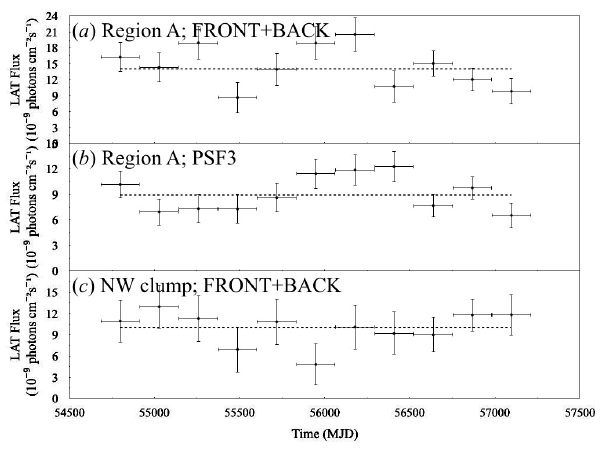1 INTRODUCTION
Within the Galactic latitude of ± 1°, a number of veryhigh- energy (VHE) sources have been discovered by imaging Cherenkov telescope arrays (e.g. Aharonian et al. 2005), among which more than 30 are unidentified TeV sources referred to as dark accelerators (according to TeVCat). The word “dark” here means that their emission mechanisms and/or cosmic-ray (CR) origins have not yet been confirmed. To reveal the nature of a dark accelerator, we can investigate its morphology, spectrum and long-term temporal behavior in γ-ray.
Two dark accelerators, HESS J1745-303 and HESS J1741- 302, are separated by ≲ 1°. Their TeV-to-X-ray flux ratios are both > 4 (Bamba et al. 2009; Matsumoto et al. 2010), making them unlikely to be associated with any supernova remnant (SNR) or pulsar wind nebula (PWN), as the typical TeV-to-X-ray flux ratio of an SNR or a PWN is < 2. Tibolla et al. (2008) created a brightness profile of these objects using a background-subtracted count-map in HESS. A double Gaussian is required to describe the data. And, therefore, these two sources are considered to be distinct.
Through a review of our two papers on Fermi observations of HESS J1745-303 (Hui et al. 2011, 2016), we concluded that this object is a molecular cloud hit by hadronic CRs accelerated in our Galactic center. If this is true, its spectrum in 30 MeV - 10 TeV should be well described by a single power-law (PL) without any spectral break (cf. Cheng et al. 2011). Therefore, comparing the spectra in the Fermi and HESS bands is an important part of the investigation.
Compared with Hui et al. (2011), Hui et al. (2016) is based on analyses with the following improvements: (1) updated instrumental response (Pass8), (2) updated Galactic diffuse background model (gll_iem_v06.fits), (3) Fermi Large Area Telescope (LAT) 4-Year Point Source Catalog (3FGL), (4) photon statistics accumulated over more than double the time-length (< 6.9 yr), and (5) refined Fermi science tools (v10r0p5).
2 MORPHOLOGY
Aharonian et al. (2008) reported that HESS J1745-303 has three emission regions in TeV, among which region A is the brightest. Both the objects 12CO J = 2-1 and HI line emissions were observed to peak at region A and to have extensions toward the northwest (Hayakawa et al. 2012).
Hui et al. (2011) reported that the 1-20 GeV emission of HESS J1745-303 in the first < 2.5 yr of Fermi LAT observations peaked on the edge of region A defined in TeV. With the aforementioned improvements, Hui et al. (2016) confirmed that the peak of this object’s 0.65-25 GeV emission in the first < 6.9 yr of Fermi LAT observations is comfortably within region A. Hui et al. (2016) also serendipitously discovered a northwest clump separated from region A by ~1.3°. This extension has the same orientation as those observed in radio line emissions. According to their brightness profiles, instead of being a single point source, region A and the northwest clump are either an extended source or a mixture of two distinct point sources (cf. Fig. 3 of Hui et al. 2016).
3 SPECTRUM
Hui et al. (2011) suggested that the 1 GeV - 10 TeV spectrum of HESS J1745-303 at region A is well fit by a PL with a photon index of 2.63 ± 0.03. With the aforementioned improvements, Hui et al. (2016) found that the 0.65 GeV - 10 TeV spectrum is well fit by a PL with a photon index of 2.49 ± 0.02; the extra parameters of the power-law with exponential cutoff (PLE) and the broken power-law (BKPL) are not strongly required.
Unlike region A, the northwest clump has a spectral shape of PLE or BKPL. The best-fit PLE has a cutoff energy of 1.90 ± 0.67 GeV; the best-fit BKPL, with the break energy fixed at 2 GeV, has a photon index of 3.66 ± 0.29 at energy greater than the break (Hui et al. 2016). Such spectral steepening is consistent with the non-detection by HESS of this clump in TeV.
4 TEMPORAL BEHAVIOR
Both Hui et al. (2011) and Hui et al. (2016) claimed no strong evidence for the long-term time-variability of flux at region A or the northwest clump. The relevant light-curves, obtained from the analyses with recent improvements, are shown in Fig. 1.

5 INTERPRETATION
Multi-wavelength (including MeV-GeV γ-ray, X-ray & radio lines) emissions of HESS J1745-303 originate from region A. The 0.65 GeV - 10 TeV spectrum at region A can be well described by a PL without any spectral break. A NW clump discovered at ~1.3° from region A has a GeV spectrum of PLE shape, and hence we speculate on possible spectral steepening along the extended feature. Synthesizing all these things, we confirmed that an energetically hadronic process is the major mechanism of γ-ray emission at region A.
It has been suggested that the mixed-morphology (MM) SNR G359.1-0.5, which is just next to region A (cf. Fig. 1 of Hui et al. 2016), is the counterpart of HESS J1745-303. However, the 0.1-100 GeV luminosity at region A of 1.1 × 1036 erg s-1 (Hui et al. 2016) is marginally consistent with the MM SNR range of ~1035 - 1036 erg s-1, as determined by Bamba et al. (2016). More importantly, HESS J1745-303 has no spectral break from hundreds of MeV to several TeV, making this object totally different from many GeV-detected SNRs which have BKPL spectra with breaks at a few GeV (Acero et al. 2016). Therefore, we have no evidence that SNR G359.1- 0.5 is the counterpart of HESS J1745-303.
The comparable emissivities of HESS J1745-303 and Sgr B2 (Yang et al. 2015; Hui et al. 2016), another cloud next to our Galactic center, suggest that they have the same CR origin: our Galactic center. However, what makes them different is that Sgr B2 has a spectral break between the GeV and TeV bands (Yang et al. 2015).









